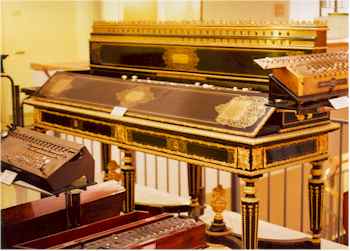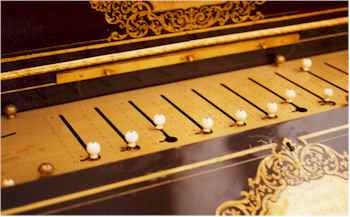| Thomas de Colmar "Piano Arithmometer" |
 |
 |
"The Piano
Arithmometer was built for the 1855 Exhibition in Paris. From there it probably
passed on to his son, Thomas de Bojano, and then to the Comte de Ronseray, the grandson of
de Colmar. The latter loaned it to the 1920 exhibition of calculating devices put on in
Paris by La Societe d'Encouragement pour L'Industrie Nationale. It was
published in their Bulletin. Your local library may have a copy of a book titled "A Computer Perspective", by the office Charles & Ray Eames, Harvard University Press, 1973. The book is about an exhibit shown in the IBM Exhibit Center in NYC. It moved, I think, to the Field Museum in Chicago, where it was shown for a long time, and now is in the possession of the FDM in Germany. Another reference is Stephen Johnston's article "Making the Arithmometer Count" in the March 1997 issue of the BULLETIN OF THE SCIENTIFIC INSTRUMENT SOCIETY. A lot of excellent information, thoroughly researched." Robert Otnes, PhD |
| Thomas de Colmar - Patent Information |
| "The
first Thomas de Colmar patent was No. 1420, 18 novembre 1820 (French). This
was the belt driven machine. The Smithsonian has an example of it. The next French patent was No. 6261, 8 decembre 1850. The patent No. 13504 is a British patent of 1851, which possibly reflects the French patent of 1850. After that, No 68923, 30 septembre, 1865. Finally, his son, Thomas de Bojano (the wife of Thomas de Colmar was the Duchess of Bojano), received patent No. 138,912, 29 septembre 1880. This was after de Colmar himself died. Most of the Thomas arithmometers, like mine, have a mechanism similar to the one described in this patent. In particular, this model has the clearing mechanism. It is still reasonably priced on the antique market ($3500 to $5000), and enough were made so that they can be found and purchased. The very few similar to the 1850 patent are another thing entirely. One of these went for $250,000 to an anonymous American buyer (most especially not me) this past year or so at Christies in London. The single example of the Thomas piano arithmometer, if IBM ever decided to sell it, might go for millions (see picture above - it is beautiful). Copies of these patents can be obtained through the Patent Express, probably on the Internet. They are a British outfit, and very good." Robert Otnes. |
| For a transcription of the British patent No. 13504 issued to Thomas de Colmar, visit Andries de Man's web site. |
| Photos are courtesy of:
Robert Otnes, PhD |